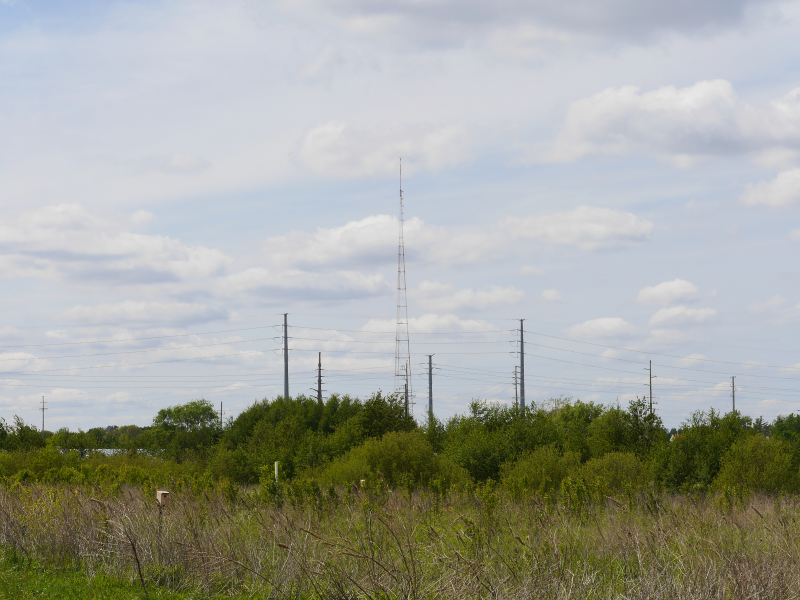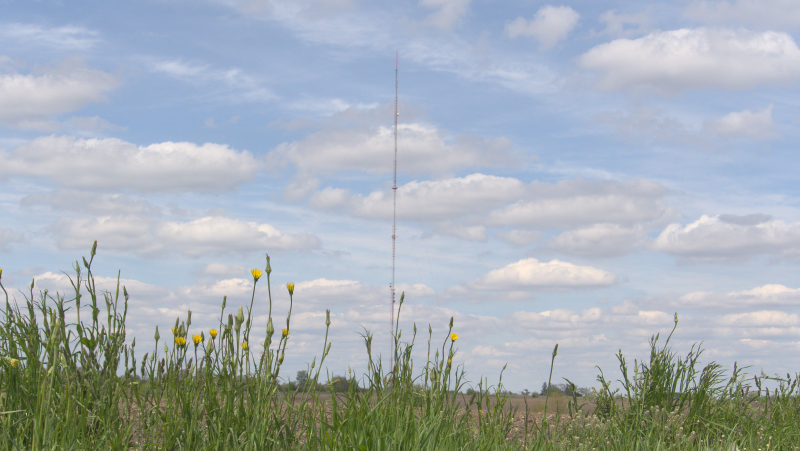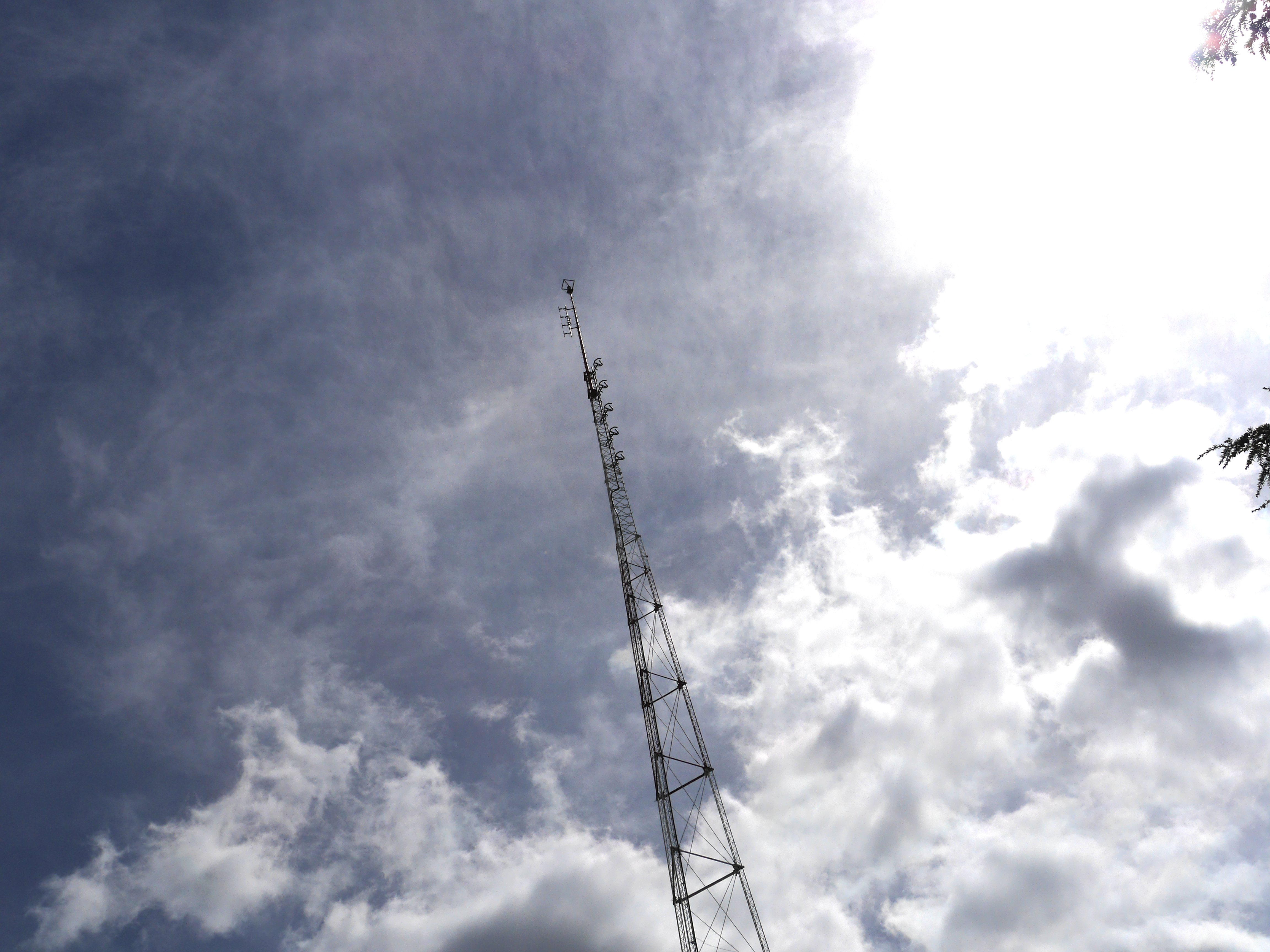WXJ-76, Champaign County’s federally-controlled weather radio station, has been absent from the airwaves since February of 2020. While there are several other weather radio stations near Champaign County, none have signals that can be picked up in Champaign-Urbana or the surrounding area.
Weather radios turn on automatically in an emergency, loudly warning your household about dangerous weather in the vicinity at any time of day or night. But presently, whether it’s a tornado, flash flood, or even a nuclear accident in the area, locals’ trusty weather radios can’t make a peep until WXJ-76 is returned to service.
That’s a problem for thousands of local families living out of audible reach of a tornado siren. And even for those living within audible range, the parties in charge of those sirens also depend heavily upon National Oceanic and Atmospheric Administration (NOAA) weather radio as a cue to actually turn them on.
Thankfully, at press time, WXJ-76 should either be back on air or just about to resume transmission. It’s been a long road back to the airwaves. Few of the station’s many avid listeners have been privy to much of an explanation until now.
****
WXJ-76’s radio silence — a silence spanning two Central Illinois tornado seasons — is not for lack of effort from the National Weather Service. “It went right to the top of the list,” says Chris Miller, acting meteorologist in charge at the NWS Lincoln office, speaking of the federal prioritization of the WXJ-76 outage. Miller’s office oversees nine NOAA weather stations in Illinois, including WXJ-76. Restoring WXJ-76’s service has been a taxing, vexing battle for Miller and his colleagues in Lincoln.
Per Miller, prolonged NOAA weather-station outages are rare. Populated, meteorologically-active service areas like Champaign-Urbana with no alternative stations in range are rarer still. When the WXJ-76 transmitter went offline, Miller recalls the federal response: “They said, ‘OK, this is going to get a high priority…we’re gonna move on this.'”
WXJ-76’s sudden disappearance from the weather-radio airwaves in early 2020 was probably a surprise to its East Central Illinois listeners. It was not, however, an unexpected event at the NWS Lincoln office. The outage had been foreshadowed by years of problems with WXJ-76’s landlord, Champaign AM radio station WDWS 1400, owned by The News-Gazette.
****
Radio towers are where weather radio transmitters have to live if they’re going to be heard by anyone. Such towers are prohibitively expensive to build and own outright. NOAA has therefore shied away from constructing towers for its weather radio stations, preferring to lease spots on existing towers instead.

WDWS Radio tower. Photo by RD Bennett.
Since the 1970s, WXJ-76’s transmitter had been housed on the WDWS 1400 broadcast tower on the corner of Neil and Windsor in Champaign, sharing the tower with their AM radio transmitter. For a commercial broadcaster, sharing your personal tower with NOAA weather radio sure looks great to the Federal Communications Commission when it’s time to renew and re-justify your broadcast license. The ongoing arrangement with WXJ-76 and WDWS on the same tower, then, provided obvious benefit to the community and WDWS alike.
However, the complex realities of the terrestrial broadcast industry and troublesome issues with WXJ-76’s equipment caused WDWS to rethink this multi-decade shared-living arrangement. In 2015 and 2016, the WXJ-76 transmitter began experiencing issues with its cabling. The problem kept cropping back up for years thereafter, threatening to cause problems for WDWS (such as audible interference on WDWS broadcasts) along the way.
Mike Haile, now-former general manager of WDWS, adds that WXJ-76’s cabling issues ultimately resulted in WDWS operating at reduced broadcast power throughout most of 2019. That is a problem for a commercial AM radio station, whose ad sales are based largely on the promise of sheer geographic reach.
Radio tower repair crews have a tough, specialized job, and are in industry-wide undersupply. Repairs on live AM radio towers are especially delicate and dangerous operations. In 2019, needed diagnostics and repairs to WXJ-76’s equipment were delayed for nearly a year due to difficulties in booking a tower crew.
Among the issues: AM transmitters must reduce power when crews are working on their towers. WDWS wanted the issues dealt with, but did not want to turn down their AM broadcast power during peak daytime hours. “Our regional HQ had to find tower climbers that were certified to do the repairs late at night, which were hard to find,” Chris Miller recalls.
The worsening hassles, delays, and signal degradation ultimately proved too much for WDWS. Haile says WDWS provided the NWS their notice in January 2019. “I told the National Weather Service that [WXJ-76] would need to vacate the tower because I just couldn’t chance, again, having [WDWS] operate at reduced power.”
Haile acknowledges the value of WXJ-76 to our community, especially in the volatile Illinois springtime. “In good conscience, we wouldn’t, as a company, heading into spring, ask them to vacate. So we told them, after the [2019] storm season… in the fall of 2019, they would need to vacate.
“In the meantime, we [at WDWS] went looking and assisting them…we found a suitable tower site for them.” Haile, a veteran of upper management at several local commercial radio stations, was a past professional associate of the other tower’s owner.
Haile says he and his broadcast engineer at WDWS personally facilitated initial talks between his tower-owning acquaintance and the federal NOAA offices in Maryland. He hoped WXJ-76 might remain on the air without interruption. “But after five months [of negotiations], my guy could never come up with a deal with the National Weather Service.”
****
In late 2019, the slow-motion disintegration of WXJ-76’s cabling at the WDWS tower began worsening, impacting WXJ-76’s transmission strength and reach.
Having given the NWS the notice to vacate in January 2020, now under new corporate ownership after The News-Gazette’s bankruptcy, WDWS proceeded to formally cancel WXJ-76’s lease in December of 2019.
It was a perfect storm for WXJ-76. Conducting the needed repairs would have been difficult, expensive, fraught with delay in hiring overbooked tower crews. WDWS had still not given NWS Lincoln a deadline to remove WXJ-76’s transmission equipment. But that deadline was probably going to be given soon, and with a forced move now imminent, repairs would have also been a waste of federal funds.
“By February,” says Miller, “the signal from WXJ-76 was so degraded that we sent our local electronics staff to WDWS to cut the cable to the antenna.”
And so, on Valentine’s Eve 2020, WXJ-76 went completely silent for an indeterminate interval, no new home in sight. On its regional website, the Lincoln NWS office posted stark warnings in red type (nothing to do with Valentine’s) that the outage was likely to last several months at minimum. All of that deadly serious red typography remained unchanged on the NWS Lincoln page for a very long time.
****
Over the following year, Miller and his Lincoln colleagues would continue to encounter substantial difficulties finding WXJ-76’s new home. They were unable to openly explain much to the public regarding their efforts or repeated setbacks. Even when providing explanations would have been legal for a tightly-regulated federal agency, publicizing the status of any ongoing talks could easily scare off the very tower-owning parties with whom the NWS needed to continue talking.
“That was kind of the frustrating thing on our end, to be honest with you,” said Miller. “Because of the length of time it was taking — and I can completely understand, you wouldn’t think that it would take this long — but we had quite a few people talking to us, basically implying that we were just sitting on our hands, nothing was getting done, ‘would you please address this?’… When there are lease negotiations going on, there is only so much we can say.”
From the very beginning of the outage, the Lincoln office received a high and continuous volume of angry local calls and emails. As the dead air dragged on and on, affected citizens also began deluging the voice mailboxes of their federal representatives. Weather radio is extremely popular in agricultural areas like Central Illinois. For rural residents, having a working weather radio may literally be the only way to receive timely notice of an actionable weather event threatening life or property.
All that noise resulted in NOAA’s Congressional Affairs office having to answer to multiple Illinois legislators. “I believe it was September,” Miller recalls, “[when] Congressman [Rodney] Davis had a meeting with the head of NOAA in Washington, DC to talk just about this issue.”
Unfortunately — or so it would seem, given the situation’s continuation for many months thereafter — none of our concerned legislators had East Central Illinois tower space to offer, either.
****
Building a new tower for WXJ-76 was still not really an option for the National Weather Service — too costly, too much to orchestrate, too much potential for even longer delays. WXJ-76’s best option was to find yet another tower owner in the service area willing to lease its tower space to the federal government.
All negotiations with local tower owners were necessarily handled by the NWS’ parent agency NOAA at federal headquarters in Maryland. The concerned meteorologists at the NWS Lincoln office could not sit directly at the table in any ongoing tower-space negotiations.
The Lincoln staff still did all they possibly could to speed things along. Drawing upon their regional familiarity and connections, they repeatedly pleaded for conversations with area tower owners. They contacted local authorities, emergency managers, and public organizations, hoping to uncover as many tower-space leads and referrals as possible.
Unfortunately, specific technical requirements also had to be met. In addition to being somewhere in Champaign county, WXJ-76’s new tower home also needed to be at least 400 feet tall.
There are hundreds of towers in Champaign County. Per FCC records, only nine of those towers are 400 feet or taller. By the time WXJ-76 was forced off air, two of those nine towers — the WDWS tower, and the tower with which WDWS had tried to play matchmaker — were already off the table. Most of the seven possible towers that remained were already full, unable to house WXJ-76.
Local weather radio fans were proving generous in their desperation. Miller recalls: “We were getting a lot of people calling us — and I really appreciate that people were stepping up — saying, ‘Hey, I know of a tower,’ or ‘Hey, I have a tower,’ or ‘Hey, I got a bunch of communication equipment on top of a grain elevator.’ We’d say, ‘Well, how high off the ground are you?’ and they’d say, ‘150, 200 feet.’ We’ve gotta be up twice that height.”
****
In early summer 2020, the NOAA federal office finally found another interested tower owner in Champaign County. Initially, talks seemed promising. At one point, NOAA’s Maryland headquarters even gave the Lincoln office the go-ahead to provide a cautiously-optimistic public status update: WXJ-76 would probably (probably!) be back on air by fall.
But later that summer, NOAA suddenly notified the Lincoln office that significant changes to government contract language had recently been mandated by Congress. “The wording in the contract, in the lease, now had to change,” recounts Miller. “They couldn’t be grandfathered in, so it was almost like starting [negotiations with the tower owner] all over again.”
Around Labor Day 2020, the tower owner took the newly rewritten contracts back to their own legal team, and the cadence of the conversation slowed. By October, the high hopes of summer had faded, and the deal appeared to be stalling.
“[At this point] we’ve been off the air for seven months, eight months, nine months,” recalls Miller. “We’re still getting phone calls from local folks, I’m getting calls from local officials… what’s going on? I don’t blame people, they want their weather radio. This is very important.”
Having begun talks with NOAA in early summer 2020, and having then gone mostly silent for much of the fall, the second prospective tower owner waited until December to give their final answer. The answer was “no.”
****

WCIA tower near Seymour. Photo by RD Bennett.
Thankfully, the third and final act of the WXJ-76 relocation saga was comparatively brief and straightforward — almost anticlimactically so. In the opening weeks of 2021, as word spread through the broadcast community about the failure of NOAA’s latest noble efforts, the Champaign television station WCIA-3 reached out to NWS Lincoln. They said they might be able to find WXJ-76 some space on their 800-foot-tall tower just west of Seymour.
Subsequent negotiations between the federal NOAA office and WCIA took only a few months, with the lease being conditionally signed between all parties in March. A series of required formalities to finalize the deal — such as structural engineering checks at the site to ensure WCIA’s tower could withstand the added weight of WXJ-76’s equipment — also moved along with relative speed and ease.
Any day now, WXJ-76 should finally resume its continuous broadcast signal, bringing tens of thousands of Central Illinois weather radios back to life, providing all within earshot with instant alerts for meteorological dangers and other potential catastrophes.
“We are very happy to see that this outage will be coming to an end soon,” says Miller, with the characteristic, stoic understatement of a public servant in the sciences. With continued luck, those in the Champaign area with weather radios may have only a few more days before they reap the benefits of his team’s perseverance.








